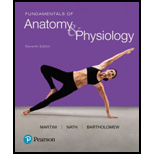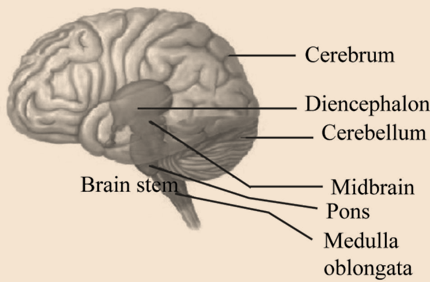
Fundamentals of Anatomy & Physiology (11th Edition)
11th Edition
ISBN: 9780134396026
Author: Frederic H. Martini, Judi L. Nath, Edwin F. Bartholomew
Publisher: PEARSON
expand_more
expand_more
format_list_bulleted
Textbook Question
Chapter 14, Problem 1CP
Name the four major regions of the brain.
Expert Solution & Answer
Summary Introduction
To determine:
The name of four major regions of the brain.
Introduction:
Brain is the most important organ in human as well as in other organisms. Brain is responsible for controlling and coordinating every action of the body. It is mainly composed of four major portions.
Explanation of Solution
Pictorial representation:
The Fig. 1 represents the four major regions of the brain:

Fig. 1: The major regions of the brain.
Explanation:
The four major regions of the brain are well represented in Fig.1, which are also well described as below:
- 1. Cerebrum: It is the largest part of the brain. It is composed of left and right hemisphere.
- 2. Diencephalon: It contains the thalamus and hypothalamus. The thalamus relays and processes the sensory information, while hypothalamus involves in hormone production, and autonomic functions.
- 3. Cerebellum: It comes 2nd after the cerebrum in size, and partially covered by the cerebral hemisphere.
- 4. Brain stem: It contains various important processing centers and nuclei. It consists of the midbrain, medulla oblongata and the pons
Want to see more full solutions like this?
Subscribe now to access step-by-step solutions to millions of textbook problems written by subject matter experts!
Students have asked these similar questions
glg 112 mid unit assignment Identifying melting processes
Give only the mode of inheritance consistent with all three pedigrees and only two reasons that support this, nothing more, (it shouldn't take too long)
O
Chapter 14 Solutions
Fundamentals of Anatomy & Physiology (11th Edition)
Ch. 14 - Name the four major regions of the brain.Ch. 14 - Prob. 2CPCh. 14 - Prob. 3CPCh. 14 - Prob. 4CPCh. 14 - Prob. 5CPCh. 14 - Prob. 6CPCh. 14 - Prob. 7CPCh. 14 - Prob. 8CPCh. 14 - Prob. 9CPCh. 14 - Prob. 10CP
Ch. 14 - Prob. 11CPCh. 14 - Prob. 12CPCh. 14 - Prob. 13CPCh. 14 - Prob. 14CPCh. 14 - Prob. 15CPCh. 14 - Prob. 16CPCh. 14 - Prob. 17CPCh. 14 - Prob. 18CPCh. 14 - Prob. 19CPCh. 14 - Prob. 20CPCh. 14 - What name is given to fibers carrying information...Ch. 14 - Prob. 22CPCh. 14 - Prob. 23CPCh. 14 - Prob. 24CPCh. 14 - Prob. 25CPCh. 14 - Prob. 26CPCh. 14 - Prob. 27CPCh. 14 - Prob. 28CPCh. 14 - LEVEL 1 Reviewing Facts and Terms 1. Identify the...Ch. 14 - Prob. 2RQCh. 14 - The term higher brain centers refers to those...Ch. 14 - Prob. 4RQCh. 14 - Prob. 5RQCh. 14 - Prob. 6RQCh. 14 - Prob. 7RQCh. 14 - Prob. 8RQCh. 14 - The centers in the pons that modify the activity...Ch. 14 - The final relay point for ascending sensory...Ch. 14 - Prob. 11RQCh. 14 - Prob. 12RQCh. 14 - The two cerebral hemispheres are functionally...Ch. 14 - Prob. 14RQCh. 14 - Which three areas in the brain are not isolated...Ch. 14 - Prob. 16RQCh. 14 - Prob. 17RQCh. 14 - Prob. 18RQCh. 14 - Prob. 19RQCh. 14 - Prob. 20RQCh. 14 - Prob. 21RQCh. 14 - Stimulation of which part of the brain would...Ch. 14 - Which structure in the brain is your AP instructor...Ch. 14 - Prob. 24RQCh. 14 - Prob. 25RQCh. 14 - Prob. 26RQCh. 14 - Prob. 27RQCh. 14 - Prob. 28RQCh. 14 - Prob. 29RQCh. 14 - Prob. 30RQCh. 14 - Cerebral meningitis is a condition in which the...Ch. 14 - Prob. 32RQCh. 14 - How would you know, just based on signs and...Ch. 14 - Prob. 2CC
Knowledge Booster
Learn more about
Need a deep-dive on the concept behind this application? Look no further. Learn more about this topic, biology and related others by exploring similar questions and additional content below.Similar questions
- Describe the principle of homeostasis.arrow_forwardExplain how the hormones of the glands listed below travel around the body to target organs and tissues : Pituitary gland Hypothalamus Thyroid Parathyroid Adrenal Pineal Pancreas(islets of langerhans) Gonads (testes and ovaries) Placentaarrow_forwardWhat are the functions of the hormones produced in the glands listed below: Pituitary gland Hypothalamus Thyroid Parathyroid Adrenal Pineal Pancreas(islets of langerhans) Gonads (testes and ovaries) Placentaarrow_forward
- Describe the hormones produced in the glands listed below: Pituitary gland Hypothalamus Thyroid Parathyroid Adrenal Pineal Pancreas(islets of langerhans) Gonads (testes and ovaries) Placentaarrow_forwardPlease help me calculate drug dosage from the following information: Patient weight: 35 pounds, so 15.9 kilograms (got this by dividing 35 pounds by 2.2 kilograms) Drug dose: 0.05mg/kg Drug concentration: 2mg/mLarrow_forwardA 25-year-old woman presents to the emergency department with a 2-day history of fever, chills, severe headache, and confusion. She recently returned from a trip to sub-Saharan Africa, where she did not take malaria prophylaxis. On examination, she is febrile (39.8°C/103.6°F) and hypotensive. Laboratory studies reveal hemoglobin of 8.0 g/dL, platelet count of 50,000/μL, and evidence of hemoglobinuria. A peripheral blood smear shows ring forms and banana-shaped gametocytes. Which of the following Plasmodium species is most likely responsible for her severe symptoms? A. Plasmodium vivax B. Plasmodium ovale C. Plasmodium malariae D. Plasmodium falciparumarrow_forward
- please fill in missing parts , thank youarrow_forwardplease draw in the answers, thank youarrow_forwarda. On this first grid, assume that the DNA and RNA templates are read left to right. DNA DNA mRNA codon tRNA anticodon polypeptide _strand strand C с A T G A U G C A TRP b. Now do this AGAIN assuming that the DNA and RNA templates are read right to left. DNA DNA strand strand C mRNA codon tRNA anticodon polypeptide 0 A T G A U G с A TRParrow_forward
arrow_back_ios
SEE MORE QUESTIONS
arrow_forward_ios
Recommended textbooks for you
 Human Physiology: From Cells to Systems (MindTap ...BiologyISBN:9781285866932Author:Lauralee SherwoodPublisher:Cengage Learning
Human Physiology: From Cells to Systems (MindTap ...BiologyISBN:9781285866932Author:Lauralee SherwoodPublisher:Cengage Learning Fundamentals of Sectional Anatomy: An Imaging App...BiologyISBN:9781133960867Author:Denise L. LazoPublisher:Cengage Learning
Fundamentals of Sectional Anatomy: An Imaging App...BiologyISBN:9781133960867Author:Denise L. LazoPublisher:Cengage Learning Biology: The Dynamic Science (MindTap Course List)BiologyISBN:9781305389892Author:Peter J. Russell, Paul E. Hertz, Beverly McMillanPublisher:Cengage Learning
Biology: The Dynamic Science (MindTap Course List)BiologyISBN:9781305389892Author:Peter J. Russell, Paul E. Hertz, Beverly McMillanPublisher:Cengage Learning Anatomy & PhysiologyBiologyISBN:9781938168130Author:Kelly A. Young, James A. Wise, Peter DeSaix, Dean H. Kruse, Brandon Poe, Eddie Johnson, Jody E. Johnson, Oksana Korol, J. Gordon Betts, Mark WomblePublisher:OpenStax College
Anatomy & PhysiologyBiologyISBN:9781938168130Author:Kelly A. Young, James A. Wise, Peter DeSaix, Dean H. Kruse, Brandon Poe, Eddie Johnson, Jody E. Johnson, Oksana Korol, J. Gordon Betts, Mark WomblePublisher:OpenStax College

Human Physiology: From Cells to Systems (MindTap ...
Biology
ISBN:9781285866932
Author:Lauralee Sherwood
Publisher:Cengage Learning



Fundamentals of Sectional Anatomy: An Imaging App...
Biology
ISBN:9781133960867
Author:Denise L. Lazo
Publisher:Cengage Learning

Biology: The Dynamic Science (MindTap Course List)
Biology
ISBN:9781305389892
Author:Peter J. Russell, Paul E. Hertz, Beverly McMillan
Publisher:Cengage Learning

Anatomy & Physiology
Biology
ISBN:9781938168130
Author:Kelly A. Young, James A. Wise, Peter DeSaix, Dean H. Kruse, Brandon Poe, Eddie Johnson, Jody E. Johnson, Oksana Korol, J. Gordon Betts, Mark Womble
Publisher:OpenStax College
Nervous System - Get to know our nervous system a bit closer, how does it works? | Neurology; Author: FreeMedEducation;https://www.youtube.com/watch?v=6O-0CVAgaEM;License: Standard youtube license